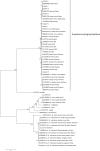Rickettsiaceae and Anaplasmataceae infections in Ixodes ricinus ticks from urban and natural forested areas of Poland
- PMID: 24661311
- PMCID: PMC3994390
- DOI: 10.1186/1756-3305-7-121
Rickettsiaceae and Anaplasmataceae infections in Ixodes ricinus ticks from urban and natural forested areas of Poland
Abstract
Background: Ixodes ricinus is a major vector for a range of microbial pathogens and the most prevalent and widely distributed tick species on the European continent, occurring in both natural and urban habitats. Nevertheless, little is known about the relative density of ticks in these two ecologically distinct habitats and the diversity of tick-borne pathogens that they carry.
Methods: We compared densities of questing I. ricinus nymphs and adults in urban and natural habitats in Central and Northeastern Poland, assessed the prevalence and rate of co-infection with A. phagocytophilum, Rickettsia, Ehrlichia and 'Ca. Neoehrlichia spp.' in ticks, and compared the diversity of tick-borne pathogens using molecular assays (PCR).
Results: Of the 1325 adults and nymphs, 6.2% were infected with at least one pathogen, with 4.4%, 1.7% and less than 0.5% being positive for the DNA of Rickettsia spp., A. phagocytophilum, Ehrlichia spp. and Ca. N. mikurensis, respectively. Although tick abundance was higher in natural habitats, the prevalence of the majority of pathogens was higher in urban forested areas.
Conclusion: We conclude that: (i) zoonotic genetic variants of A. phagocytophilum are widely distributed in the Polish tick population, (ii) although the diversity of tick borne pathogens was higher in natural habitats, zoonotic species/strains were detected only in urban forests, (iii) and we provide the first description of Ca. N. mikurensis infections in ticks in Poland.
Figures


References
-
- Medlock JM, Hansford KM, Bormane A, Derdakova M, Estrada-Peña A, George JC, Golovljova I, Jaenson TG, Jensen JK, Jensen PM, Kazimirova M, Oteo JA, Papa A, Pfister K, Plantard O, Randolph SE, Rizzoli A, Santos-Silva MM, Sprong H, Vial L, Hendrickx G, Zeller H, Van Bortel W. Driving forces for changes in geographical distribution of Ixodes ricinus ticks in Europe. Parasit Vectors. 2013;6:1. doi: 10.1186/1756-3305-6-1. - DOI - PMC - PubMed
Publication types
MeSH terms
Substances
Associated data
- Actions
- Actions
- Actions
- Actions
- Actions
- Actions
- Actions
- Actions
- Actions
- Actions
- Actions
- Actions
- Actions
LinkOut - more resources
Full Text Sources
Other Literature Sources
Molecular Biology Databases
Miscellaneous

